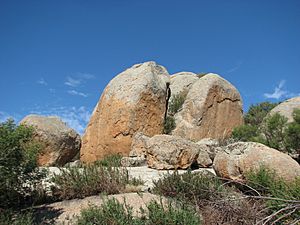Mount Hope (Victoria) facts for kids
Quick facts for kids Mount Hope |
|
|---|---|

Mount Hope from the north west
|
|
| Highest point | |
| Elevation | 202 metres (663 ft) AHD |
| Geography | |
| Climbing | |
| First ascent | 1836 by Thomas Livingstone Mitchell |
Mount Hope is a granite rock formation located in northern Victoria, Australia. It stands north of Pyramid Hill. This special rock is part of the 126-hectare Mount Hope Nature Conservation Reserve. Parks Victoria looks after this reserve.
At the reserve, you'll find picnic tables and a dirt parking area. It's a great spot for rock climbing and watching birds! There are also some communication towers near the top of the mountain.
Contents
History of Mount Hope
In 1836, a Scottish explorer named Thomas Livingstone Mitchell was the first European to see Mount Hope. He climbed it on June 28, after spotting it a few days earlier. He was very excited to see it because he had been traveling through flat country for months.
Mitchell wrote about his discovery:
This hill was made of huge granite blocks. It was a welcome sight after traveling through so much flat land. I hoped to see a lot from its top, so I named it Mount Hope.
While on the summit, Mitchell found two new plant species: Philotheca pungens and Hibbertia incana. He also saw a remarkable hill in the distance, which we now know as Pyramid Hill.
Mitchell described Pyramid Hill like this:
A remarkable hill of granite appeared 5 1/3 miles from Mount Hope... It is a triangular pyramid and, being quite isolated, it closely resembles the monuments of Egypt.
Seeing the promising land from Mount Hope, Mitchell decided to change his route to explore it further.
Early Explorers and Animals
In 1838, Joseph Hawdon also climbed Mount Hope. He was moving cattle between Howlong in New South Wales and Adelaide in South Australia. Hawdon noticed a small animal on the hill:
This hill appears to be inhabited by a small Kangaroo of fawn colour, with a most beautiful head, and about the size of an English hare. I shot one, and preserved its skin.
This small kangaroo was an eastern hare-wallaby. Sadly, this animal species became extinct a few years after the first European settlers arrived.
In 1845, a large sheep farm called Mount Hope Station was set up. It covered about 77,000 acres and had 100,000 sheep!
In 1857, there were rumors of gold in the area, which led to a "gold rush." However, no gold was ever found at Mount Hope.
Burke and Wills Expedition Visit
On September 1, 1860, members of the famous Burke and Wills expedition climbed Mount Hope. One of them was Ludwig Becker, who was a naturalist, geologist, and artist.
Becker wrote about the mountain:
The whole mountain chain is Granit of a very coarse character, brittle, and fast decomposing. Immense blocks stretch their backs alongside the hills, where they look like petrified Wales and Elephants of pre-adamitic dimensions. It was surprising to see the great number of butterflies, moths and other insects swarming about the rich, blooming vegetation growing out from between the crevices of the gigantic boulders.
Becker even made a watercolor drawing of the view from the summit, looking towards Pyramid Hill.
The Mount Hope Quarry
For a time, there was a quarry at Mount Hope. Stone from this quarry was used to build roads in nearby towns like Cohuna, Boort, and Kerang after World War II.
A company bought the quarry in 1952 to get gravel and stone. However, the stone wasn't the best quality, and the quarry didn't have electricity for the crushing machines. So, the quarry closed in 1958, and its equipment was moved to another location.



